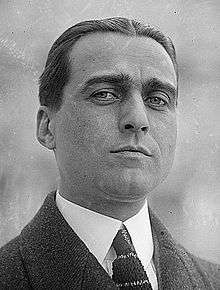James Clement Dunn
James Clement Dunn (December 27, 1890 – April 10, 1979) was an American diplomat and a career employee of the United States Department of State. He served as the Ambassador of the United States to Italy, France, Spain, and Brazil. He had lived in Rome since his retirement in 1956.
James Clement Dunn | |
|---|---|
 James Clement Dunn in 1921 | |
| 11th United States Ambassador to Brazil | |
| In office March 11, 1955 – July 4, 1956 | |
| President | Dwight D. Eisenhower |
| Preceded by | James S. Kemper |
| Succeeded by | Ellis O. Briggs |
| 12th United States Ambassador to Spain | |
| In office April 9, 1953 – February 9, 1955 | |
| President | Dwight D. Eisenhower |
| Preceded by | Lincoln MacVeagh |
| Succeeded by | John Davis Lodge |
| 16th United States Ambassador to France | |
| In office March 27, 1952 – March 2, 1953 | |
| President | Harry S. Truman Dwight D. Eisenhower |
| Preceded by | David K. E. Bruce |
| Succeeded by | C. Douglas Dillon |
| 16th United States Ambassador to Italy | |
| In office February 6, 1947 – March 17, 1952 | |
| President | Harry S. Truman |
| Preceded by | Alexander Comstock Kirk |
| Succeeded by | Ellsworth Bunker |
| 1st and 4th Chief of Protocol of the United States | |
| In office June 11, 1933 – April 11, 1935 | |
| President | Franklin D. Roosevelt |
| Preceded by | Warren Delano Robbins |
| Succeeded by | Richard Southgate |
| In office February 4, 1928 – November 17, 1930 | |
| President | Herbert Hoover |
| Preceded by | Office established |
| Succeeded by | F. Lammot Belin |
| Personal details | |
| Born | December 27, 1890 Newark, New Jersey |
| Died | April 10, 1979 (aged 88) West Palm Beach, Florida |
| Cause of death | Myocardial infarction |
| Spouse(s) | Mary Augusta Armour |
| Children | 2 |
| Profession | Diplomat |
Born in Newark, on December 27 of 1890, and privately educated, Dunn at first wanted to become an architect, an interest that remained with him all his life.
In 1917 he became assistant naval attaché to Haiti. In 1920, he was made a third secretary at the embassy in Spain, a post he held for two years. He was chargé d'affaires in Port-au-Prince, Haiti, in 1922-24. After other assignments, he became a first secretary at the American embassy in London. From 1928-1930 he served as the first person to hold the office of Chief of Protocol of the United States. In 1930-35, served as counsel to the Commission for the Study of Haiti. Dunn was chief political adviser to the Berlin Conference in 1945; deputy at the American meetings of the Council of Foreign Ministers in London, Paris and New York in 1945-46.
When representatives from 50 nations convened in San Francisco in April to June 1945 to form the United Nations Dunn 'worked hard behind the scenes to create a pro-French consensus' and to protect France's colonial interests in French Indochina. He was once called a 'fascist' by Eleanor Roosevelt for his views on colonial matters.[1]
In 1946 he was a member of the delegation at the Paris Peace Conference.
Dunn was a governor of the Metropolitan Club and a member of the Knickerbocker Club, the River Club, the Regency Club and the Whist Club in New York, and of the Alibi Club in Chevy Chase, Md. Ambassador Dunn retired from the Service in 1956 with the rank of Career Ambassador.[2]
He died in Florida in 1974.[3]
Dunn was survived by his wife, the former Mary Augusta Armour; two daughters Marianna Dunn of Manhattan and Cynthia Esterlechner of West Germany; three grandchildren and nine great-grandchildren.
James Clement Dunn Award for Excellence
In 1980, the U.S. Department of State established this award to recognize exemplary performance in the Department of State at the mid-career level (Foreign Service FS-1 or Civil Service GS/GM-15). It was made possible by an endowment from the Vincent Astor Foundation and is named, at the request of the donor, in memory of Ambassador Dunn. The recipient receives a certificate signed by the Secretary of State and $10,000.[4]
The James Clement Dunn Award for Excellence recognizes leadership, intellectual skills, managerial ability, and personal qualities that most fully exemplify the standards of excellence desired of officers at the mid-career level.[4] Past recipients include ambassadors William Burns, Nicholas Burns, Jeffrey Feltman, Carey Cavanaugh, and Robert Stephen Ford.
References
- Logevall, Fredrik (2013). Embers of War. Random House. p. 89. ISBN 9780375504426.
- "James C. Dunn, 88, U.S. Ambassador To Four Countries After War, Dies". The Washington Post. April 14, 1979. Retrieved June 18, 2018.
- "James Clement Dunn, U.S. Diplomat in Europe" (fee). The New York Times. 1979-04-11. Retrieved 2007-08-27.
- "3 FAM 4830 ANNUAL AWARDS". US State Department.
External links
- The Political Graveyard: Brief biography
- United States Department of State: Chiefs of Mission by Country, 1778-2005
| Diplomatic posts | ||
|---|---|---|
| Preceded by Alexander C. Kirk |
United States Ambassador to Italy 1946–1952 |
Succeeded by Ellsworth Bunker |
| Preceded by David K. E. Bruce |
United States Ambassador to France 1952–1953 |
Succeeded by C. Douglas Dillon |
| Preceded by Lincoln MacVeagh |
United States Ambassador to Spain 1953–1955 |
Succeeded by John Lodge |
| Preceded by James S. Kemper |
United States Ambassador to Brazil 11 March 1955–4 July 1956 |
Succeeded by Ellis O. Briggs |
